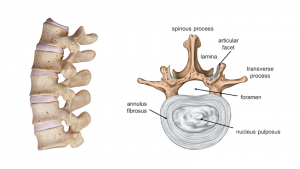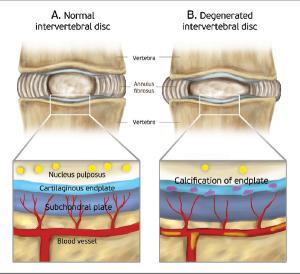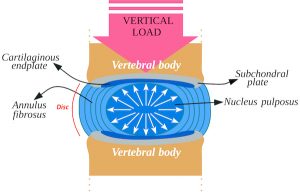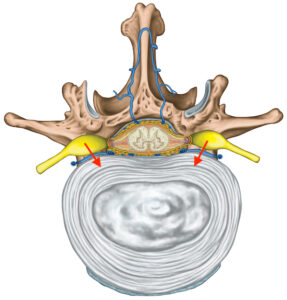So, where is the back pain coming from?
There is a possible explanation for this mysterious back pain. Interestingly, research has brought evidence showing that back pain, in particular low back pain, can be independent of nerve compression as frequently seen in disc herniation, but originate directly from the disc itself due to local inflammatory changes within the disc. This is called discogenic pain or painful degenerative disc disease.
Defining discogenic pain
A few decades ago, the term discogenic low back pain was coined to define the condition without knowing its exact aetiology, but it’s only now that we are beginning to understand what’s behind it in terms of pathophysiology.
 Anatomy of the intervertebral disc
Anatomy of the intervertebral disc
Intervertebral discs are positioned between the vertebrae. They confer stability and flexibility to the spine and prevent friction between them. They are flat and round structures, with a thickness of about a half-inch. They are made of two parts:
Nucleus pulposus located at the centre filled with a jelly-like material
Annulus Fibrosus – the flexible outer ring of the disc. Made of several concentric layers, similar to elastic bands, which adapt to vertebral movements.
The annulus fibrosus and nucleus pulposus are rich in collagen fibres. These fibres are distributed in a regular pattern within the 25 layers (lamellae) of the annulus pulposus, whereas in the nucleus pulposus, they are arranged in a random fashion to entrap specific proteins called proteoglycans that confer resistance to compression. The combination of these structures confers resistance to compression of the intervertebral disc.
Illustration published by Tomaszewski et al. in Folia Morphol, 2015
Nutrient pathways in a normal disc (a) and degenerated disc (b). The nutrients reach the disc by diffusing from the capillaries located in the vertebral body, then penetrate the subchondral plate and finally the cartilage endplate. This supply is reduced in disc degeneration due to atherosclerosis of the lumbar arteries and calcification of the cartilage endplate. This leads to a reduction of viable cells in the disc.
Early stages of disc degeneration, the underlying cause of discogenic back pain
It is recognised that in the early stages of disc degeneration, well before visible structural changes appear, there are subtle molecular and cellular alterations that can trigger back pain.
Normally, the process of disc degeneration begins with ageing as a result of mechanical stress to the spine, reduced nutrition and oxygenation of the disc due to the mineralisation of the spine cartilage (“end plate”, see image), which is the major vehicle of nutrients to the disc.
This lack of nutrients compromises the composition of collagen, the major constituent of the disc fibres, and promotes the production of enzymes that digest/disrupt those fibres, contributing to the degradation of the disc structural organisation. These abnormalities diminish disc elasticity and reduce the disc height. This process is sufficient to induce discogenic pain, which can be protracted over time. When this degenerative process progresses further, the disc strength is weakened, potentially leading to the extrusion of the nucleus pulposus and disc herniation, which in turn will compress the adjacent nerves eliciting pain.
What is the physiological mechanism leading to discogenic back pain?
The answer is inflammation. Inflammatory mediators released in the disc are sufficient to cause pain. Both animal studies and post-mortem investigations on humans revealed that disc cells as well as inflammatory monocytes (immune cells circulating in the blood) that have migrated into the degenerated disc release inflammatory proteins called cytokines.
Interestingly, the production of cytokines in the disc is also observed in the absence of spine pathologies. The cytokines identified in association with discogenic back pain are tumour necrosis factor-alpha (TNF-a) and IL-8, offering the opportunity for treatment through the pharmacological inhibition of these inflammatory factors.
Although still uncertain, the onset of disc inflammation and thus discogenic pain seems to be influenced by a variety of factors:
When the intervertebral disc (blue) is compressed by a vertical load, it causes the expansion of the nucleus pulposus and compensation by the more rigid outer annulus fibrosus. Over time mechanical loading can begin inflammatory and thus degenerative processes.
Mechanical loading
It is known that mechanical loading exerted on the intervertebral disc has a significant impact on the metabolic processes within the disc. However, only recent research has proven that mechanical stress can also trigger disc inflammation. Most evidence was obtained from animal experiments whereby the compression of discs, resulted in the production of cytokines and other inflammatory factors.
Hereditary causes
The development of discogenic pain may have a hereditary predisposition, whereby the genes controlling the production of cytokines and collagen are abnormally regulated enhancing inflammation and altering the healthy composition of the fibres in the disc, which in turn facilitates disc degeneration.
Inflammation
The production of cytokines is sustained by cytokines themselves so that when the disc is exposed to cytokines their synthesis is enhanced further by disc cells themselves as shown in laboratory experiments using cultured disc cells. This evidence confirms the ability of the disc itself to support local inflammatory processes. Interestingly, the production of cytokines has been found to be more significant in symptomatic discs compared to asymptomatic discs.
Ageing enhances disc inflammation
With ageing, there is a spontaneous increase in the production of cytokines within the disc, with higher levels in the nucleus pulposus compared to the annulus fibrosis.
How do cytokines affect disc health?
Locally produced cytokines stimulate the synthesis of proteases, namely enzymes able to digest proteins, which will cause the breakdown of the disc fibres such as collagen. These processes are responsible for disc degeneration.
Cross section of the vertebra showing the dorsal root ganglia in yellow from where the newly formed nerve endings (red arrows) grow into the outer disc mediating pain sensation.
How is disc pain generated?
The presence of nerves in the disc is only limited to the outer portion of the annulus fibrosus. But with inflammation building up in the disc, cytokines stimulate the secretion of neurogenic molecules (e.g. nerve growth factor), which promote the growth of sensory nerves into the disc. These sensory nerves originate from the dorsal root ganglia situated just outside the disc. Both immune and neurogenic factors can stimulate discogenic and radicular pain elicited in the neurons of the adjacent nerve root ganglia.
In a fascinating study, the presence of these nerve endings deep into the disc has been confirmed in 57% of discs collected from patients with low back pain. The researchers also found a clear association between pain and the nerve fibres density in the disc whereby, painful discs have a higher number of such nerve fibres compared to non-painful discs.
Neovascularisation, or the formation of new blood vessels in the disc, is another phenomenon regulated by increased cytokines. This is mediated by the ability of cytokines to induce endothelial cell growth factors, which stimulate the formation of new vessels.
Conclusion
The current elucidation of the molecular and cellular mechanisms inherent to discogenic pain clearly attributed a pivotal role to disc inflammation as the major driver of the changes in the disc conformation at the basis of discogenic pain. Because pain is subjectively perceived, the combination of the ongoing physiological processes with the individual response to pain will make the condition relatively complex. Ongoing research is focusing on identifying potential biomarkers for early identification of disc pathology so that the onset of inflammatory processes can be halted before the irreversible degeneration of the disc.
Important facts about back pain
The impact of back pain on health care systems and socioeconomic expenditure
Back pain represents an enormous socioeconomic expenditure to health care systems in all developing and developed countries including Australia.
- The numbers
Globally, more than 540 million people are affected by low back pain to the point of limiting their mobility. The incidence of low back pain has doubled in the past 25 years, potentially increasing further in the years to come along with the growth of our ageing populations.
- Second leading cause of disease burden
In 2015, back pain was the second leading cause of disease burden in Australia and approximately 4 million people, or 1 in 6 Australians, had back problems in 2017-18. In this period there were 181,000 hospitalisations for back issues, which included disc disorders, sciatica and back pain from unknown origins.
- Major cause of work disability
Among the different types of back problems, low back pain in particular remains the major cause of work disability, sickness absence, loss of productivity and early retirement from employment, leading to serious socioeconomic concerns for the person affected.
- The Australians and back pain
On a daily basis, 24% of Australians suffer from low back pain, and within a month, 50% of the population reported of having back pain. This simple statistic reveals the real health burden of this issue in our country. The cost sustained for the care of patients with low back pain is estimated at $4.8 Billion per year.
- Back pain and medical negligence
Monash University reported a series of articles published in The Lancet by international and Australian authors, stating that low back pain is associated with medical negligence, misinformation and delivery of nonconform diagnostics and therapies, which may not only be unnecessary but even harmful.
- Unnecessary treatment
In the article it is argued that interventions such as X-rays and scans, opioids, injections and surgery are often pointless. This wrong approach to the care of low back pain reflects our lack of understanding of its pathophysiology. Therefore, further research is required to better elucidate the aetiology of low back pain in order to be addressed with suitable therapeutic strategies.
- Back pain has medico-legal implications
Work related low back pain also has important medico-legal implications as it involves the employer, the employee, the work insurer and the legal representatives. Therefore, establishing the occupational triggers leading to back pain and formulating the exact diagnosis and treatment, are critical to assisting the worker to improve their health, receive the appropriate compensation and ensure a safe return to employment.



